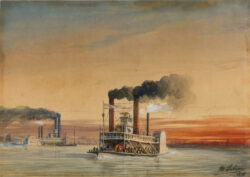Hippolyte Sebron
Hippolyte Sebron resided in Louisiana for a brief time, from 1849 to 1855, but he had a profound effect on the development of landscape and genre painting in the state.

Courtesy of The Historic New Orleans Collection
Steamboats on the Mississippi at New Orleans. Sebron, Hippolyte Victor Valentin (Artist)
Eippolyte Sébron resided in Louisiana for a brief time, from 1849 to 1855, but he had a profound effect on the development of landscape and genre painting. His most ambitious paintings, such as Giant Steamboats at New Orleans (1853), have an experiential quality that compares to Albert Bierstadt’s monumental canvases depicting the California wilderness. Of equal importance, Sébron was among the earliest to capture the distinctive Louisiana landscape — notably the bayous that would become such an essential subject for later landscapists such as Richard Clague and William Buck. Other Louisiana artists such as Victor Pierson and Paul Poincy are indebted to Sébron, as is evident in their monumental collaborative effort, Parade of the Volunteer Firemen, in the collection of the Louisiana State Museum.
Sébron was born in Caduebec-en-Caux, France. He trained with Leon Cogniet at the École des Beaux Arts in Paris. He debuted at the Salon in Paris in 1825, showing landscapes painted during travels throughout Europe. Sébron’s paintings have a combination of grand scope and focus on detail similar to that in Cogniet’s L’Expédition d’Egypte sous les ordres de Bonaparte (1798), yet they lack the emotional charge, romanticism, or interest in politics that had dominated advanced painting in the 1820s and 1830s.
In 1827, Sébron began working with the scenographer and photographic pioneer Louis-Jacques Mande Daguerre. He painted at least fourteen of thirty large-scale paintings measuring sixty-five by forty feet depicting scenery under dramatic lighting (achieved by using transparencies) for another of Daguerre’s inventions, the diorama. There seems to have been some controversy over credit for these works, and Sébron eventually left Daguerre’s employ. He traveled to England, where he painted parts of a diorama, was in Spain and Portugal in 1838, in Italy in 1840, again in England in 1844, and in Morocco in 1846. King Louis-Philippe commissioned Bapteme de Monseigneur Comte de Paris dans l’Eglise Notre-Dame de Paris, May 2, 1841, for the museum at Versailles, and King William II bought at least two of Sébron’s paintings.
By the time Sébron arrived New York City in 1849, he was a highly accomplished academic artist and decorative painter. Having observed the business acumen of Daguerre, Sébron proved a sophisticated businessman, spending the next six years traveling in the United States and Canada, though most of his time was spent in New York and New Orleans. He often added a large-scale painting of a nearby locale to increase local interest. In New Orleans, Sébron showed views of New York and Richmond, Virginia, as well as a spectacular scene of Niagara Falls. These paintings functioned somewhat like travelogues or a documentary film may today, revealing distant locales in a vivid manner. Paintings of such scale were not uncommon in New Orleans. John Vanderlyn had exhibited a panorama of Versailles in 1821–1822 (with limited success), and theatrical scene painting occupied the brushes of many artists. However, the precision, ability to create dramatic lighting effects, and degree of finish sets Sébron apart from his peers in Louisiana. His style is polished and cool, reflecting new trends in European academic practice during the late 1840s and early 1850s. Like Alfred W. Boisseau, he capitalized on interest in exotic locales and burgeoning American cities in Europe. Sébron wrote near the end of his life that he believed that his six-year journey through the United States was “certainly the most comprehensive made by an artist in this country.” Still, the taste for art in America, he noted, was but moderate, and artist were forced to survive by painting portraits and drawing pastels. Sébron returned to France in 1855. He continued to travel, painting landscapes and interiors marked by intense chiaroscuro effects. He died in Paris in 1879.
